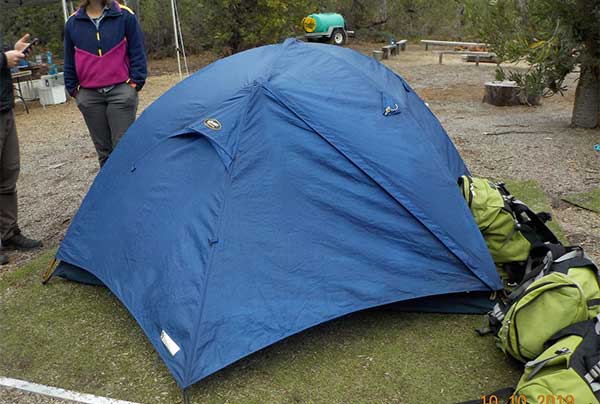How well protected your tent is from the weather will have a big impact on your camping experience.
Nobody likes waking up in a wet, soggy tent with water pouring in through the seems, or going to bed shivering because your tent is poorly insulated.
The first way to avoid these negative camping experiences is of course to choose your day wisely: camping is best in the warmer months when you can carry less gear and not have to stress about plummeting temperatures and heavy downpours.

If you are camping in the winter months it’s best to invest in a quality tent purpose-built for the cold months. Likewise, if you’re expecting rain, a waterproof tent with a waterproof rainfly, tubbed floor, and protected seams is always advised.
However, there are a few other ways in which you can weatherproof your tent to keep you as protected as possible. In this article, we’ll be exploring several ways in which you can do this.
Table of Contents
Waterproofing your tent
A lot of tents come with a DWR coating - that’s Durable Water Repellant - however, this can wear down in time.
If you’ve just bought a tent with DWR, you’ll be good to go. However, if you’ve had your tent for a while you may notice the coating is flaking off, in which case you’ll need to refresh it.
You can test your tent’s coating by spraying it with water and seeing whether the water beads on the surface or soaks through.
Re-apply the urethane coating
The urethane coating on your tent can flake off over time, so if you’ve noticed any flakes it’s probably an indicator that it’s time to reapply.
- Lay the tent out on a dry, flat surface before scrubbing off any flaked coating.
- Using a tent sealant, follow the manufacturer’s instructions to apply a thin coat over the material.
- Allow this to dry for at least 24 hours.
Re-apply the DWR coating
The DWR coating is what makes water bead up on your tent and prevents it from soaking through.
- Clean the tent’s flysheet if necessary, spraying it down with water - you don’t need to wait for it to dry.
- Apply a tent waterproofing spray evenly over the fly, as per the manufacturer’s instructions.
- You can wipe off any excess coating with a soft, damp cloth before leaving it to dry thoroughly.
Waterproofing a polycotton tent
Polycotton tents and canvas tents are slightly different as they require weathering before you use them.
They do have a water-repellent coating, but this needs to ‘activated’ before it becomes effective. You can do this by giving the tent a light hosing down, which allows the weave of the fabric to tighten up, making it more waterproof.
Re-seal the seams
The seams of the tent are the easiest place for water to leak through. Just like the rest of your tent, the seams should have a waterproof coating, but this will gradually wear away with use.
Re-seal the seams of your tent on a dry day or choose an indoor spot such as a garage where you can leave the tent to dry.
- Set up your tent and turn the flysheet inside out so you can access it more easily (you’ll have to seal the seams on the inside of the tent and the underside of the flysheet).
- You want to ensure the seams are clean first, so use rubbing alcohol and a soft cloth or sponge to gently remove any peeling coating.
- Use a seam sealer that is designed for the material of your tent. Bear in mind that polyurethane-coated materials need a different seam sealer to a silicone-treated one.
- Apply the sealer following the manufacturer’s guidelines and leave it to dry.
Insulating your tent
If you’re camping in cold weather, it’s also important to insulate your tent to keep cold air and wind out. You can do this in the following ways:
- Insulate the floor of the tent with heavy-duty reflective foam to trap air and reflect heat back to you
- Insulate the roof of your tent and the walls, to prevent heat from rising and escaping.
If you’re interested in finding out more about insulating your tent, we’ve written a more in-depth guide on this here:
How to Winterize Your Tent – Grand Circle Trails
Protecting your tent from wind
The best way to protect your tent from wind is to pick a spot that is out of the wind, ideally somewhere that’s sheltered by trees or bushes that can act as a natural windbreak.
However, you can also build a windbreak as an added barrier of protection from harsh winds.
You can do this by securing a heavy-duty tarp between two trees that are upwind of your tent using a durable rope, or use whatever natural resources you have to hand: snow, bushes, or even rocks, to build a wall that will take the brunt of the wind.
Other considerations for weatherproofing your tent
The groundsheet
The groundsheet is essential for keeping water out of your tent, and the best tents have a tubbed floor with a sewn-in groundsheet.
You can also add an extra layer of protection by pitching your tent on top of a tarp.
Coatings
If you know you’re going to be camping in adverse conditions, it can sometimes be a good idea to apply a second layer of coating to your tent.
Waterproof rating
You can tell how waterproof your tent is by checking its waterproof rating, which is measured in the hydrostatic head (HH). HH shows the depth of a column of water the tent can withstand before the water starts to soak through the fabric.
So a tent with a 4,000mm HH would be able to cope with a column of water 4,000mm deep. The higher the HH rating, the better.
Quality
A cheap tent won’t hold up well in heavy rain and wind. It’s definitely worth investing in a high-quality tent with a waterproof rainfly, tubbed, sewn-in groundsheet, and protected seams.
Also, consider things like the quality of the tent poles - steel or carbon fiber poles are the best options.
- Are Merrell Shoes Good? – An Unbiased Review of Merrell Footwear - December 9, 2023
- Where Are Merrell Shoes Made? - December 9, 2023
- Camping in 40-degree Weather: Tips and Tricks - September 25, 2023

![Why Your Campfire Smokes So Much? [Quick Answers You Should Know] Why Your Campfire Smokes So Much? [Quick Answers You Should Know]](https://grandcircletrails.com/wp-content/uploads/2021/09/Why-Your-Campfire-Smokes-So-Much-1-150x150.jpg)
![Are Mittens Warmer Than Gloves? [Quick Answers You Should Know] Are Mittens Warmer Than Gloves? [Quick Answers You Should Know]](https://grandcircletrails.com/wp-content/uploads/2021/11/hiking-glooves-1-150x150.jpg)
![Are Hammocks Better Than Beds? [Quick Answers & Questions] Are Hammocks Better Than Beds? [Quick Answers & Questions]](https://grandcircletrails.com/wp-content/uploads/2021/12/Are-Hammocks-Better-Than-Beds-1-150x150.jpg)
![How to Shower When Camping? [Quick Answers] How to Shower When Camping? [Quick Answers]](https://grandcircletrails.com/wp-content/uploads/2022/02/How-to-Shower-When-Camping-1-150x150.jpg)

![Best Wood for Campfires [Everything You Need To Know] Best Wood for Campfires [Everything You Need To Know]](https://grandcircletrails.com/wp-content/uploads/2021/11/Best-Wood-for-Campfires-1-150x150.jpg)